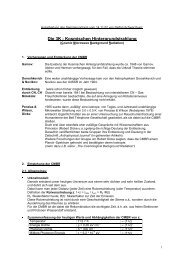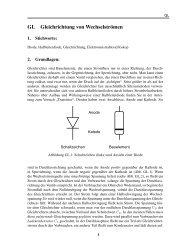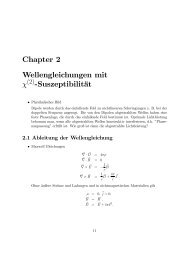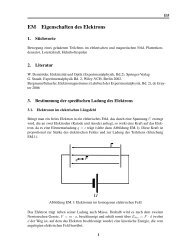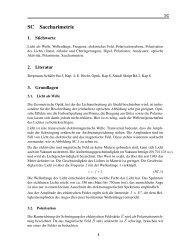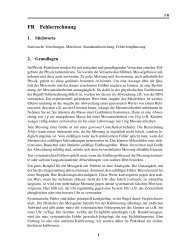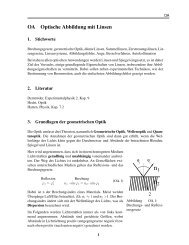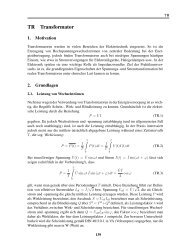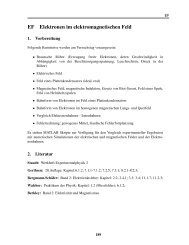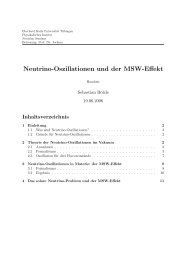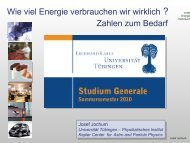26. passage of particles through matter - Particle Data Group
26. passage of particles through matter - Particle Data Group
26. passage of particles through matter - Particle Data Group
You also want an ePaper? Increase the reach of your titles
YUMPU automatically turns print PDFs into web optimized ePapers that Google loves.
<strong>26.</strong> Passage <strong>of</strong> <strong>particles</strong> <strong>through</strong> <strong>matter</strong> 15<br />
Positrons<br />
Lead (Z = 82)<br />
0.20<br />
− 1 dE (X −1<br />
E dx 0 )<br />
1.0<br />
0.5<br />
Electrons<br />
Ionization<br />
Møller (e − )<br />
Bhabha (e + )<br />
Bremsstrahlung<br />
0.15<br />
0.10<br />
(cm 2 g −1 )<br />
0.05<br />
0<br />
1<br />
Positron<br />
annihilation<br />
10 100 1000<br />
E (MeV)<br />
Figure <strong>26.</strong>9: Fractional energy loss per radiation length in lead as a function <strong>of</strong><br />
electron or positron energy. Electron (positron) scattering is considered as ionization<br />
when the energy loss per collision is below 0.255 MeV, and as Moller (Bhabha)<br />
scattering when it is above. Adapted from Fig. 3.2 from Messel and Crawford,<br />
Electron-Photon Shower Distribution Function Tables for Lead, Copper, and Air<br />
Absorbers, Pergamon Press, 1970. Messel and Crawford use X 0 (Pb) = 5.82 g/cm 2 ,<br />
but we have modified the figures to reflect the value given in the Table <strong>of</strong> Atomic<br />
and Nuclear Properties <strong>of</strong> Materials (X 0 (Pb) = 6.37 g/cm 2 ).<br />
<strong>26.</strong>4.2. Energy loss by electrons: At low energies electrons and positrons primarily<br />
lose energy by ionization, although other processes (Møller scattering, Bhabha scattering,<br />
e + annihilation) contribute, as shown in Fig. <strong>26.</strong>9. While ionization loss rates rise<br />
logarithmically with energy, bremsstrahlung losses rise nearly linearly (fractional loss is<br />
nearly independent <strong>of</strong> energy), and dominates above a few tens <strong>of</strong> MeV in most materials<br />
Ionization loss by electrons and positrons differs from loss by heavy <strong>particles</strong> because<br />
<strong>of</strong> the kinematics, spin, and the identity <strong>of</strong> the incident electron with the electrons which<br />
it ionizes. Complete discussions and tables can be found in Refs. 8, 9, and 28.<br />
At very high energies and except at the high-energy tip <strong>of</strong> the bremsstrahlung<br />
spectrum, the cross section can be approximated in the “complete screening case” as [37]<br />
dσ/dk =(1/k)4αre{ 2 (<br />
4<br />
3<br />
− 4 3 y + y2 )[Z 2 (L rad − f(Z)) + ZL ′ rad ]<br />
+ 1 9 (1 − y)(Z2 + Z) } (<strong>26.</strong>22)<br />
,<br />
where y = k/E is the fraction <strong>of</strong> the electron’s energy transfered to the radiated photon.<br />
At small y (the “infrared limit”) the term on the second line can reach 2.5%. If it is<br />
ignored and the first line simplified with the definition <strong>of</strong> X 0 giveninEq.(<strong>26.</strong>18), we have<br />
dσ<br />
dk =<br />
A<br />
X 0 N A k<br />
( 43<br />
− 4 3 y + y2) . (<strong>26.</strong>23)<br />
June 18, 2002 13:57



